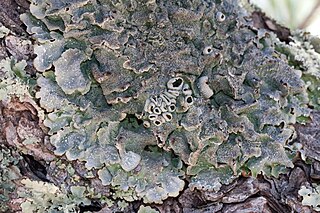Waynea is a genus of lichenized fungi in the family Ramalinaceae. It was circumscribed in 1990 by Swedish taxonomist Roland Moberg, with W. californica assigned as the type species.

Pilophorus acicularis, commonly known as the nail lichen or the devil's matchstick lichen, is a species of matchstick lichen in the family Cladoniaceae.
Acarospora flavisparsa is a species of lichen in the family Acarosporaceae. Found in Portugal and Spain, it was described as new to science in 2011. The lichen grows on acidic rock walls in inland areas.

Lecanora muralis(Protoparmeliopsis muralis) is a waxy looking, pale yellowish green crustose lichen that usually grows in rosettes radiating from a center (placodioid) filled with disc-like yellowish-tan fruiting bodies (apothecia). It grows all over the world. It is extremely variable in its characteristics as a single taxon, and may represent a complex of species. The fruiting body parts have rims of tissue similar to that of the main nonfruiting body (thallus), which is called being lecanorine. It is paler and greener than L. mellea, and more yellow than L. sierrae. In California, it may be the most common member of the Lecanora genus found growing on rocks (saxicolous).
Punctelia jujensis is a species of foliose lichen in the family Parmeliaceae. It is found in Argentina and Brazil.

Punctelia hypoleucites, commonly known as the southwestern speckled shield lichen, is a species of foliose (leafy) lichen in the family Parmeliaceae. First formally described by Finnish botanist William Nylander as a species of Parmelia, it was transferred to the genus Punctelia in 1982. The lichen is found in Africa, North America, and South America, where it grows on the bark of both hardwood and coniferous trees. Its greenish-grey thallus is covered with tiny white pseudocyphellae – minute holes in the thallus surface that facilitate gas exchange. Some macroscopic features that help distinguish this species from other related members of the genus include the presence and the structure of the apothecia, the absence of asexual surface propagules, and the light brown color of the thallus undersurface. Chemically, the presence of lecanoric acid in the medulla and atranorin in the cortex help distinguish it from lookalikes.

Hypogymnia flavida is a species of foliose lichen in the family Parmeliaceae. It is found in mountainous locations of east Asia, where it grows on the bark and wood of woody plants. It has a relatively large yellowish thallus.
Ocellularia diospyri is a rare species of corticolous (bark-dwelling) lichen in the family Graphidaceae. It is found in northern Thailand.
Astrochapsa sipmanii is a little-known species of corticolous (bark-dwelling) lichen in the family Graphidaceae. It is found in Singapore.

Malmidea attenboroughii is a species of corticolous (bark-dwelling), crustose lichen in the family Malmideaceae. It is known to occur from a single location in the Amazon rainforest of Bolivia.
Elixia cretica is a rare species of corticolous (bark-dwelling), crustose lichen in the family Elixiaceae. It is only known to occur in a single location in the mountains of the Greek island of Crete.
Lecanora panticapaensis is a species of saxicolous (rock-dwelling), crustose lichen in the family Lecanoraceae. It occurs in a single locality in Dnipropetrovsk Oblast, Ukraine, where it grows on the vertical surfaces of black schist beside a river.
Micarea pauli is a species of corticolous and lignicolous, crustose lichen in the family Pilocarpaceae. It is only known to occur in Poland's Białowieża Forest.
Lecania leprosa is a species of saxicolous (rock-dwelling), crustose lichen in the family Ramalinaceae. It occurs in Eastern Europe.
Inoderma sorediatum is a species of crustose lichen in the family Arthoniaceae. It is only known to occur on the bark of trees in Poland's Białowieża National Park. It is differentiated from other species in genus Inoderma by the form of its thallus, which is entirely made of powdery, granular soredia, as well as by the presence of a unique combination of lichen products.
Oxneria ussuriensis is a species of corticolous, crustose lichen in the family Teloschistaceae. It is found in a single location in the Russian Far East.
Biatora pacifica is a species of corticolous (bark-dwelling), crustose lichen in the family Ramalinaceae. It is found in Russia, Japan, and South Korea, where it grows along the Pacific coast. It inhabits the bark of a variety of coniferous and deciduous plants.
Biatora radicicola is a species of corticolous (bark-dwelling) and saxicolous (rock-dwelling), crustose lichen in the family Ramalinaceae. It is found in various locations in Europe, where it grows in sheltered and humid microhabitats, often on exposed root bark at the base of trees.
Gallowayella aphrodites is a species of corticolous (bark-dwelling), foliose (leafy) lichen in the family Teloschistaceae. It is found in the Mediterranean countries Greece, Cyprus, and Italy. Characteristics of the lichen include its small thallus, the disposition of the rhizines on the thallus undersurface, and the lack of vegetative propagules.
Pyrenula luteopruinosa is a species of corticolous (bark-dwelling), crustose lichen in the family Pyrenulaceae. It has a neotropical distribution, occurring in Panama, Costa Rica, Puerto Rico, and Hawaii.




